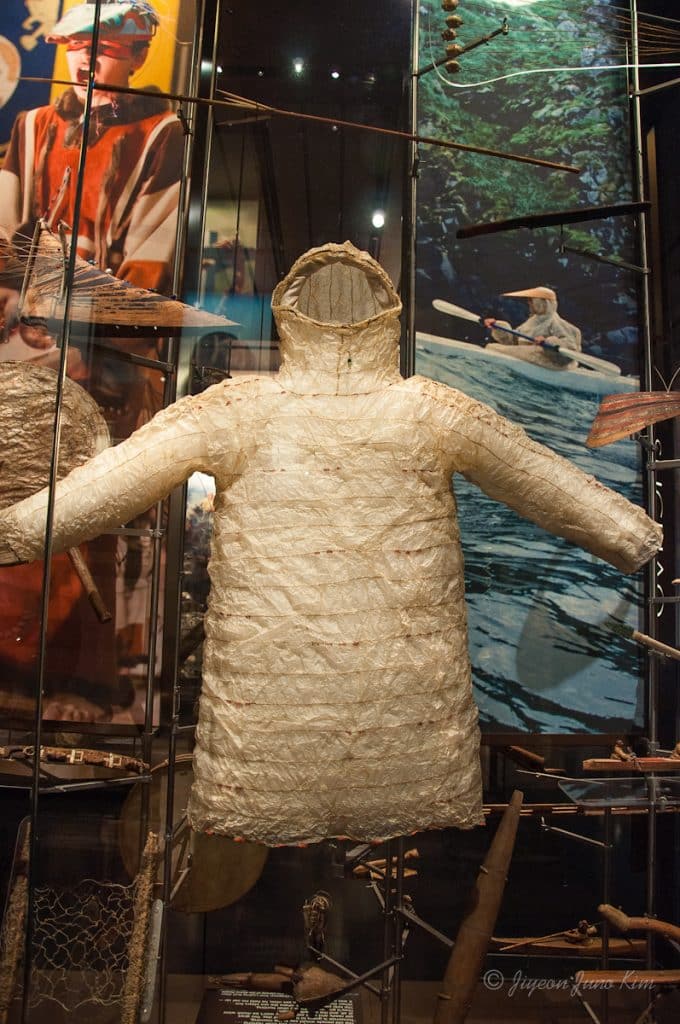You will find the natural gore-tex, gut parka, in Alaska
Isn’t it amazing to learn how much more our ancestors knew about the world, than what we know now? We think that technology’s evolved, that all the studies and Google helped us understand the world better, but in fact, we know so little about the ‘real’ world. A special piece of artifact, a gut parka, I saw in Alaska made me think a lot about this.
As I’m traveling the world, I see one obvious trend in the direction civilization is heading. We started small, as nature intended to. We lived in houses made with natural materials, got things to eat from plants and animals, and learned the skills to survive the harsh winter and summer. As people formed civilization, they started trading their skills and stocks for things they needed, such as medicine or jewelry. We had traditional markets (what people used to call just ‘market’). From some time ago to this day, people found the need to build warehouses full of groceries and house supplies. They didn’t need to negotiate prices with the seller, because in fact, they didn’t even know who they were. This is the direction developing countries want to go.


Traditional knowledge of Alaska Native Peoples
Now people are slowly realizing how important and valuable those ‘traditional’ markets were when things were naturally organic. The neighborhood I grew up in still has the traditional market I used to go to with my mom. People at one point got fascinated by big western-style supermarkets, but more are realizing how good we originally had it. Asian cuisine and oriental medicine are slowly coming to the Western world. From time to time I encounter these movements that motivate people to go back to the olden days in the States as well. Get your meat from the butcher, vegetables from the nearby garden, and fruit from the orchards. Just like what my parents, grandparents, and their grandparents did. It’s astonishing how much our ancestors knew about the relationship between the human body and nature. Today we are re-learning what our ancestors already found out centuries ago.

The all-natural raincoat: gut parka, chag^talisax^
There was one item that drew my attention at the Arctic Studies exhibit at the Anchorage Museum in Alaska. It looked like a thin plastic poncho. It is labeled ‘gut parka’. The original name is chag^talisax^, meaning gut parka or rain gear in the Unangam Tunuu (Eastern Aleut dialect) language. Women sewed waterproof ‘raincoats’ using the gut (intestine) of any large sea mammal. The design included a hood with a drawstring. Men always wore this in their kayaks to keep dry, usually with a bird skin parka underneath.
How genius is this? This is possibly the world’s very first high-tech wind and waterproof outdoor gear, natural gore-tex if you will, that humans ever made. Somehow, they discovered that a large sea mammal’s intestines were great at holding out water. Not only the parka was made from it, but they also made fishing baskets with the same material. All these artifacts were dated from 1893. The Native Alaskans were the masters at how to live off the land they had. They were never greedy but knew how to utilize everything they possessed. They made a waterproof backpack out of the whole seal’s body. The fur was used to make winter gear. They made games and recreational products with the same materials and sometimes decorated the chief’s outfit.
Think about what people do these days. People hunt the shark for only its fin. They cut the fin and leave the shark to slowly drown. Hunting for the gallbladder of a bear, a small fraction of its total weight, is what made bears extinct in certain parts of the world. As we speak, rhinos are dying because people want their horns. We all know elephant ivories are one of the most valuable things on the black market.
It’s astonishing. I wonder what Native people would think of these kinds of incidents, that people kill animals because of a false belief and vanity.
To remind myself of the ingenuity of Native Peoples, I came back with a small earring made with seal gut, made by an Alaska Native artist.
Something to think about.

Many museums in Alaska have it. In Anchorage, check out Anchorage Museum and Alaska Native Heritage Center. Morris Thompson Cultural and Visitors Center and Museum of the North in Fairbanks are great museums. I also saw one in Valdez Museum. Inupiaq Heritage Center in Utqiagvik and Alutiiq Museum in Kodiak also have great resources.
The original name is chag^talisax^, meaning gut parka or rain gear in the Unangam Tunuu (Eastern Aleut dialect) language. Women sewed waterproof ‘raincoats’ using the gut (intestine) of any large sea mammal. The design included a hood with a drawstring. Men always wore this in their kayaks to keep dry, usually with a bird skin parka underneath.